The Best Hinged Knee Brace for Your Needs
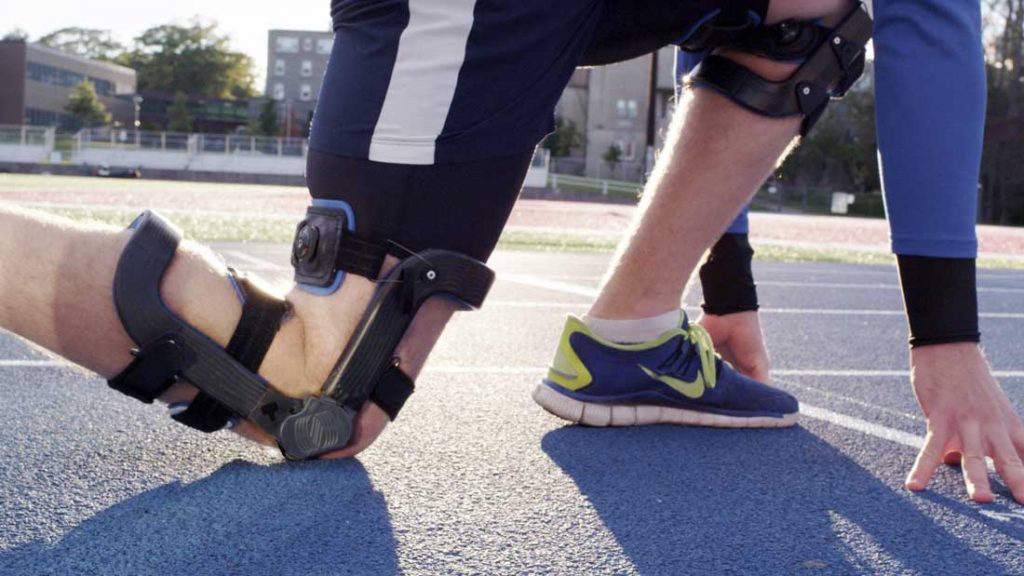
There is a lot of variety when it comes to hinged knee braces. To list just a few types, hinged knee braces include functional, prophylactic, offloading, rehabilitative – and the list goes on. Some target only a narrow category of treatment, while others are more multi-functional. Making things even more confusing, not all braces are supported by research. In many cases, the evidence is inconclusive. So out of all this information, what is the best hinged knee brace for your needs?
Because you deserve to know which braces could actually help you, this article is a research-based overview of the main categories of hinged knee braces. For your ease, we’ve organized the content into several sections. While we recommend reading it all in order, feel free to click on a topic if you have a specific question in mind:
Why wear a hinged knee brace?
As the name suggests, hinged knee braces include hinges. The hinges typically connect solid bars that run alongside the leg. The hinges and bars work together to stabilize the knee by limiting certain movements. A hinged brace can prevent hyperextension, control the speed and range of leg movements, and promote a certain alignment of the joint.
Hinged braces are typically worn when the knee is unstable or vulnerable to more damage, such as in cases involving injury, surgery recovery, or knee osteoarthritis. In comparison, non-hinged knee braces include products such as sleeves and compression braces. Because they do not include hinges or bars, they offer less support but more freedom of movement. As a result, sleeves and compression braces are better suited for treating knee conditions that are mild or moderate in severity. If you want to learn more about when to choose a non-hinged knee brace, check out this guide for everything you need to know.
While your basic hinge provides stability and controlled movement, some are serious multi-taskers. As companies have continued to roll out newer brace technologies, innovation has reached even the hinges themselves. The hinge of the Levitation brace by Spring Loaded, for example, contains compact liquid springs. During a knee bend, the liquid springs store energy and reduce pressure on the joint. When the leg extends, the springs release the energy to assist the user. As a result of this groundbreaking technology, people with serious injury or impairment can experience the benefits of powerful knee extension assistance without the bulk or price tag of a robotic exoskeleton.
Types of hinged knee braces
The best hinged knee brace won’t be the same for everyone. If you’ve already been browsing options for hinged knee braces, you’ll likely have noticed them categorized in a few different ways. We’ll explain the categories as simply as possible to help you make an informed decision.
At the most basic level, hinged braces can be categorized as either rigid or soft. A rigid hinged brace restricts movements more than a soft hinged brace, and as a result offers more support to the joint. You can usually tell whether a hinged brace is rigid or soft, depending on how evident the side bars are.
You may also see hinged braces categorized according to their purpose. Until 2008, the American Association of Orthopaedic Surgeons defined knee braces as prophylactic, functional, rehabilitative, and patellofemoral 1.
The types of hinged knee braces used here
As brace technology has changed over the years, more brace categories have been described. As you encounter a variety of hinged knee brace types, keep in mind that there is no standardized list. The categories mainly serve to help companies describe the different types of braces to their customers. In addition, some braces may not neatly fall under one particular category, while others may be designed to treat more than one condition.
For the purpose of this article, we will use the categories of prophylactic, functional, and offloader. Rehabilitative braces tend to overlap with functional and offloader braces, depending on the type of injury or surgery recovery they target. Because of this, this article will discuss rehabilitative bracing as a subcategory of both functional and offloader bracing.
Although patellofemoral bracing is another popular brace type, these are typically not hinged. As such, we will limit our discussion of patellofemoral braces to the one hinged knee brace that is able to target this area.
Prophylactic Braces
Prophylactic braces are hinged knee braces worn for the purpose of preventing injury and are typically used by athletes. They were first used in the 1990s by the US National Football League and later spread to college-level football and other sports2.
Across most sports today, prophylactic bracing is less popular than it used to be. However, they are still commonly used by linemen in US college-level football2.
Prophylactic braces are intended to protect the knees when they encounter forces that push them inward (valgus stress) or rotational stress3. These braces supposedly protect the medial collateral ligament (MCL) from injury, as well as help the cruciate ligaments keep the joint stable3.
Cruciate ligaments include the anterior cruciate ligament (ACL) and posterior cruciate ligament (PCL). They are pairs of ligaments that form an X. The ACL and PCL are responsible for stabilizing the knee by preventing back and forth movements within the joint.
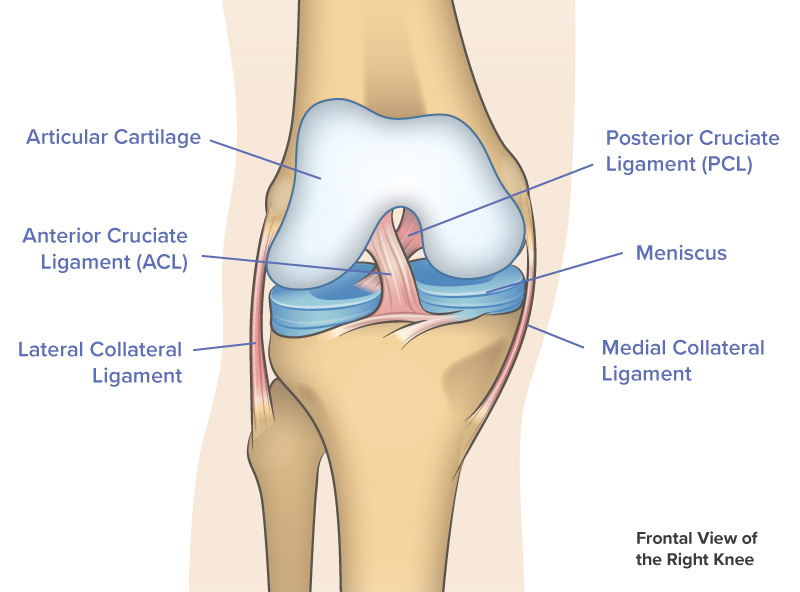
To date, it is unclear whether prophylactic braces actually prevent injury. Studies in the early 1990s suggest that prophylactic braces reduce MCL injuries4-6. However, more recent studies call these results into question by pointing out flaws in the research6,7. For the most part, results on the effectiveness of prophylactic braces are inconclusive1,7,8. As a result, prophylactic braces cannot be recommended or discouraged with high confidence.
Functional Braces
Functional braces are designed to protect and support knees after injury or reconstructive surgery9. They were originally made to support the knees of athletes who were recovering from ACL injuries10.
There have been a number of advances within functional bracing. Firstly, there is a greater variety of them than ever before. Newer types include braces that treat the PCL or have added rehabilitative benefits. New mechanical components have also been added to their design. Dynamic tensioning systems, for example, correct joint positions by applying a load to the knee.
With the proliferation of functional bracing, it seems research can hardly keep up. To date, research on functional bracing has produced mixed results on its effectiveness1,11.
While functional braces may support your knee during rotational movements, like when you pivot12, they do not seem to prevent abnormal movements of your shin bone (which is important in many sports)10,13. Additionally, functional braces do not appear to improve physical performance if you have had an ACL reconstruction14-16.
Offloader Braces
Offloaders are knee braces that treat knee osteoarthritis (OA). Most braces for knee OA work by redistributing force from the unhealthy knee compartment to the healthy compartment.
Compared to prophylactic and functional braces, you might notice that knee OA braces usually only have one bar running along one side of the leg. This is because the single bar helps redistribute pressure across the knee. When there is a bar on only one side of the leg, the brace is described as unilateral. In comparison, a hinged brace with two bars on the sides is called a bilateral brace.
With the help of its unilateral hinge, the brace applies pressure to one side compartment. This compartment is usually the only knee compartment affected by OA, or at least the compartment most affected by the disease. As a result, the brace shifts the user’s body weight and other joint forces to the healthier and stronger tibiofemoral compartment.
Conventional Offloaders
Companies typically market their hinged knee braces for OA as offloaders. You may also see these braces described as uni-compartment offloaders or valgus/varus braces.
Uni-compartment offloading refers to the reduction of knee joint forces within a single knee compartment. Although the knee has three compartments – two side compartments and a kneecap – a uni-compartment offloader can only act on the side compartments. This is because this type of brace works by applying a load to one side of the knee. As a result, joint pressures are shifted from one side of the knee to the other.
Valgus and varus are terms that describe the direction of the force acting on the knee. Valgus means going inward while varus means going outward. So if you encounter a uni-compartment valgus offloader, you would know that it targets OA in the inner (medial tibiofemoral) knee compartment.
Uni-compartment offloaders and valgus/varus braces shift forces within the knee, rather than entirely eliminating forces over the entire joint. Depending on your individual OA pattern, you may find a tri-compartment offloader brace to be the best hinged knee brace for you.
Tri-compartment Offloaders
Tri-compartment offloader braces work by removing forces across the entire knee. There is currently only one on the market – the Levitation brace by Spring Loaded. Previously, exoskeletons were the only type of technology that could remove forces across the entire joint.
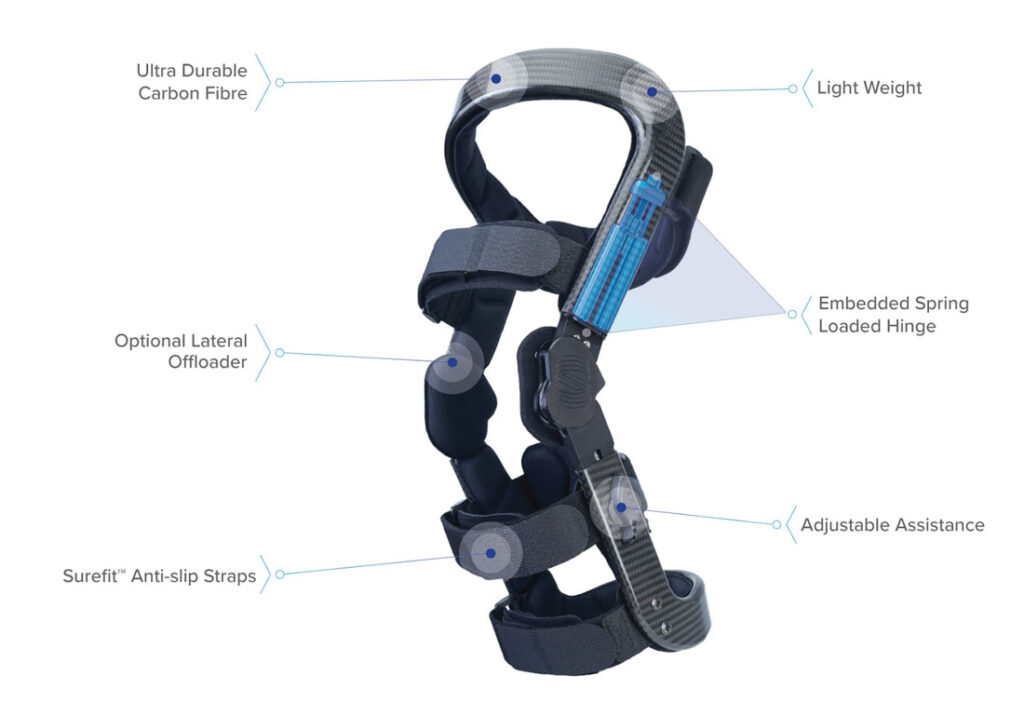
To learn whether a uni-compartment or tri-compartment offloader brace is best suited for your condition, jump to this article’s Knee Osteoarthritis section.
To learn more about the different knee OA patterns, take a look at our Guide to Knee Osteoarthritis.
The best hinged knee brace for your needs
Injury Prevention
If you play a sport where your knee is frequently pushed inwards or rotated, a prophylactic brace may help support your ligaments3. However, it is important to note that the current state of research does not conclusively support the use of prophylactic braces.
At worst, prophylactic bracing may cause more injuries1. At best, these braces may support your joints during certain movements. For example, prophylactic bracing has been shown to support the knee perform movements associated with ACL injuries17.
If you are still set on finding a prophylactic brace, some brands have performed well in certain tests. The Drytex Economy hinged knee brace by Donjoy, for example, has performed well in squatting and proprioception tests18. Proprioception refers to your ability to gauge your body’s position and movement. The “H” Buttress by DonJoy has performed well in balance tests18. Finally, longer prophylactic braces are recommended over shorter ones, since they are able to better protect the MCL3.
Recovery from Injury or Surgery
ACL and PCL Injuries
In the case of ligament injuries, functional braces were initially created to target the treatment of ACL injuries or ACL reconstruction. The Rebound ACL Knee Brace by Ossur, marketed as the next generation of ACL bracing, includes a dynamic tensioning system (DTS) that applies a load to the thigh and tibia. As a result of its DTS, forces acting on the ACL are reduced when the leg goes from a bent to straight position. The Rebound is primarily intended to be worn after ACL reconstruction.
In recent years, PCL functional braces have been released. Like the ACL, the PCL stabilizes the knee. While the ACL prevents the tibia from moving too far forwards, the PCL prevents the tibia from moving excessively backwards.
PCL functional braces are marketed as dynamic force PCL braces. They work by applying a counteracting force against the backwards movement of the tibia. These braces are encouraged as a supplementary treatment to PCL injury management.
The first dynamic force PCL brace to be launched was the Ossur Rebound PCL Knee Brace. Like the company’s ACL counterpart, the brace includes a DTS that applies a counter force on the tibia. As a result, the PCL is supported during leg bending and straightening19,20. Another PCL brace with research support includes the Albrecht Jack PCL brace21.
Meniscus Injuries
For mild acute tears of the meniscus or degenerative meniscus tears, a hinged knee brace can be a useful contribution to your overall treatment strategy22,23.
Some research shows that uni-compartment offloaders can minimize meniscal strain, so long as your ACL is healthy24. You can read more about treating meniscus injuries here.
ACL Reconstruction
In patients with a weakened or reconstructed ACL, there is evidence that a brace with a dynamic tensioning system (DTS) can reduce the amount of strain put on the meniscus25. A brace with a DTS may also protect the ACL after reconstruction, preventing future injury25.
If you are returning to sports after ACL reconstruction, wearing a functional brace likely won’t interfere with your physical performance26. However, functional braces may give you a false sense of security, and could result in injury if you push yourself too hard1,10.
Rehabilitation from Injury or Surgery
You may also encounter functional rehabilitative braces, which are a type of functional brace that offers rehabilitative benefits to the knee after repeated use9. Some rehabilitative benefits include improvements in knee function, lessened knee pain, and increased muscular strength9.
The Guardian’s Rehabilitator line includes braces designed for PCL injury and OA management. Both the company’s PCL Rehabilitator and OA Rehabilitator include pneumatic air bladders that apply either a dynamic force against the tibia or the knee joint, respectively. In clinical studies, the OA Rehabilitator has resulted in increased quadriceps strength after repeated use27,28. Similar effects can be expected to occur with the PCL Rehabilitator since it shares its quadriceps strengthening mechanism with the OA Rehabilitator.
Knee Osteoarthritis
Depending on your specific knee OA pattern, the best hinged brace for you may be an offloader knee brace. To learn more about the different knee OA patterns, take a look at our Guide to Knee Osteoarthritis.
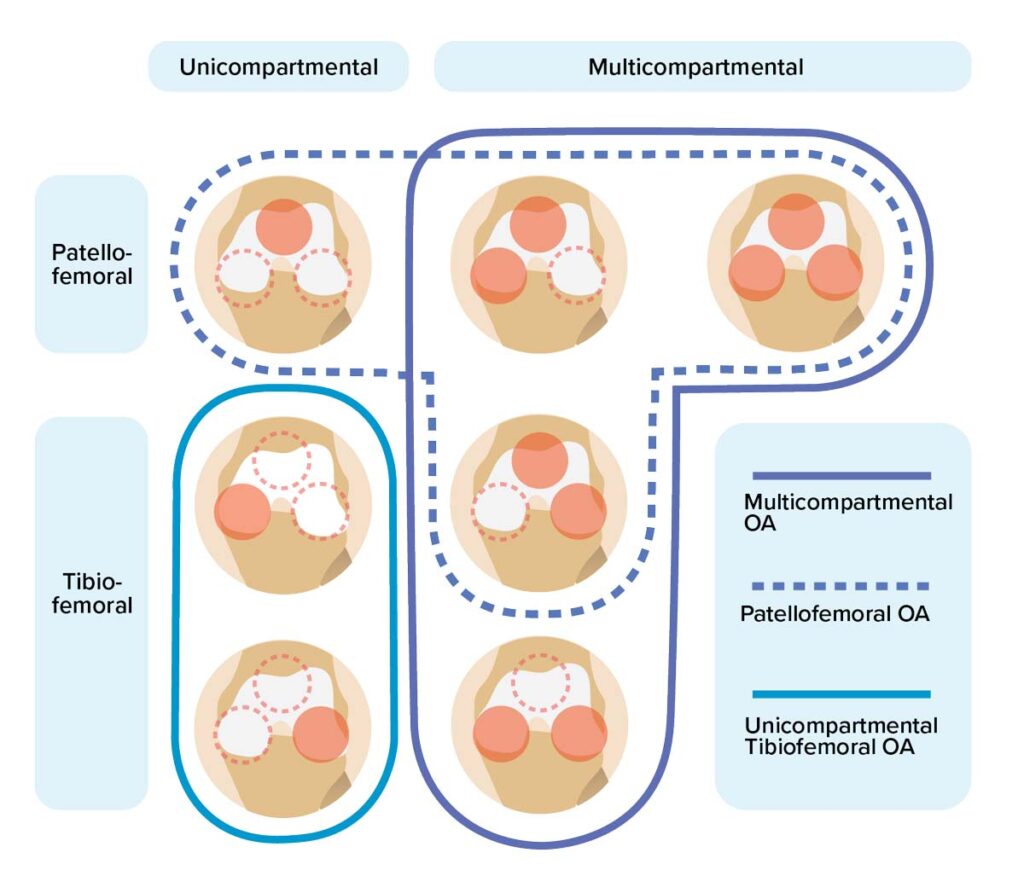
Osteoarthritis in One Side of the Knee
If you have osteoarthritis in only one of your knee’s side compartments, your arthritis pattern would be described as unicompartmental tibiofemoral. For this condition, uni-compartment offloader bracing may be an effective short-term solution29,30. However, this type of bracing may be best suited for managing only small to moderate amounts of knee pain31.
There is some long-term promise to wearing a uni-compartment offloader knee brace. One study showed that patients who wore this type of offloader for two years were less likely to need knee surgery 8 years later32. At the same time, many patients with knee OA choose to use this type of brace while they wait for their eventual knee surgery32. In that case, a uni-compartment offloader bracing may be a cost-effective way to manage your symptoms before you undergo surgery, if you end up needing it.
Popular hinged braces for unicompartmental TF include the Donjoy Defiance and the Breg Solus Plus. Additionally, the Guardian OA Rehabilitator is an innovative brace that includes a pneumatic air bladder to redistribute forces across the knee. The Rehabilitator also offers the benefits of increased quadriceps and hamstring strength after repeated use27,28.
Downsides to Uni-compartment Offloader Bracing
Unfortunately, uni-compartment offloaders are only effective at treating a small number of knee OA cases. Since these braces redistribute pressure from one side of the knee to the other, they can only treat OA that presents in one of these compartments. This disease pattern represents only 4-20% of all knee OA cases33-35.
Additionally, the long-term benefits of using a uni-compartment offloader brace are not very clear30,31,36. This is partly because long-term studies (those done over multiple years) are difficult to conduct. Most patients do not wear their braces consistently for multiple years, making it hard for researchers to make conclusions about long-term bracing effects36.
Osteoarthritis in Multiple Compartments or in the Kneecap
If your knee OA pattern does not fit the description of unicompartmental tibiofemoral, then you likely have the disease in multiple compartments and/or in your kneecap. These remaining cases are seen in approximately 80% of knee OA patients33-35.
Unfortunately, uni-compartment offloader bracing likely won’t provide adequate pain relief or sufficient improvements to your function if you are like the majority of knee OA patients.
Typical treatments for OA isolated to your kneecap include taping and knee sleeves. Taping works by adjusting the position of the patella to reduce the load applied on the patellofemoral compartment36. Knee sleeves work similarly by aligning the kneecap in a certain way and providing stability to the front of the knee36.
More recently, tri-compartment offloader braces have come onto the market. They are currently the only hinged knee brace that can target OA in the kneecap or in multiple compartments. Tri-compartment offloaders can also treat unicompartmental tibiofemoral OA, although you do have a number of other bracing options if that is your disease pattern. But if your disease pattern is outside the realm of unicompartmental tibiofemoral, tri-compartment offloaders are an unparalleled bracing solution.
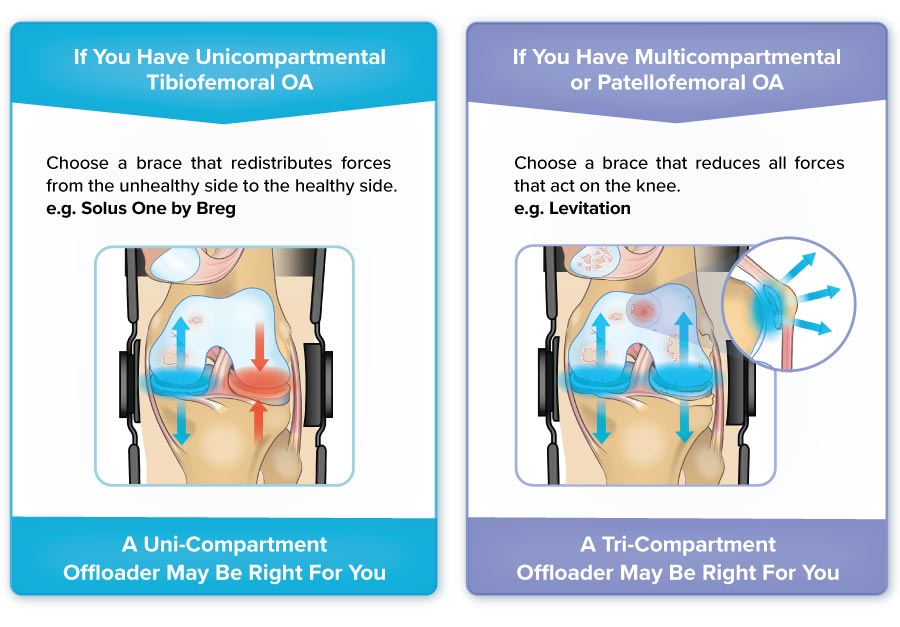
Tri-compartment Offloaders
The first, and currently only, tri-compartment offloader on the market is the Levitation brace by Spring Loaded. The brace contains liquid springs inside its hinges, which allow it to reduce pressure across the entire knee, including the patellofemoral compartment37. Its innovative design has been shown to significantly reduce a number of joint forces38.
As a result of its powerful offloading capabilities, Levitation users experience substantial pain relief. 95% of Levitation users report pain relief as a result of wearing the brace, while 67% report using one less treatment method for their arthritis39. The brace has also been shown to significantly increase knee function, physical activity levels, and quality of life39.
Additional Benefits of the Levitation Knee Brace
Another huge benefit of Levitation is that it can support your exercise and weight management goals. For many knee OA patients, exercise and weight loss are highly recommended first-line treatments40-42. In reality, these treatments can be difficult to sustain, due to knee pain, lack of function and mobility, and lowered metabolism and energy levels due to dieting. But by reducing knee pain, improving function, and supporting increased physical activity levels39, Levitation can make it a lot easier to stick to an exercise or weight loss regimen.
Other standout features of Levitation include its lightweight and compact design and leg extension assist. Its assist is so powerful that at a 90-degree knee bend, Levitation can reduce knee joint forces by an amount equivalent to losing 45 lb of bodyweight37. As a result, Levitation can result in outcomes similar to weight loss. And while you may not do a lot of deep knee bends throughout the day, Levitation has been shown to support everyday actions like crouching, getting up from a chair, and walking up and down stairs43.
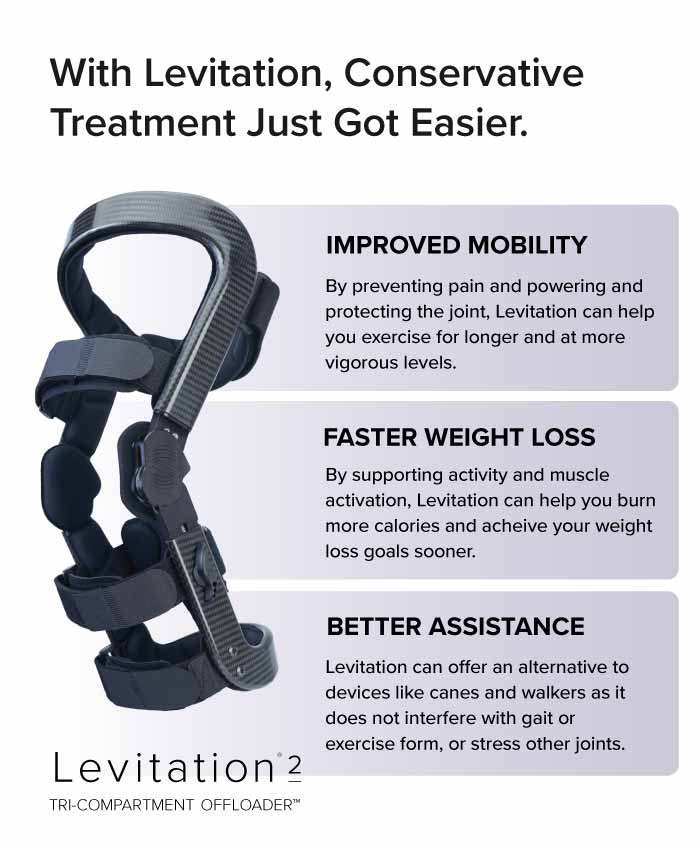
Features of a High Quality Hinged Brace
Once you do find the category of hinged knee brace that best suits your needs, you may still need to do some shopping around for the best brand. To help you in that effort, there are a few features that can distinguish a high quality brace.
Comfort & Breathability
Because you’ll be wearing your brace for a stretch of time, you want to make sure the brace fits comfortably. If you live in a warm climate, or plan to use the brace during athletic activities, you also want to make sure it’s breathable. Moisture for long periods of time promotes bacterial growth, which can lead to unpleasant odours.
Look for moisture wicking materials like neoprene, spandex, and nylon. Meshing or open areas to allow air flow will also ensure the brace is comfortably breathable.
Compressive Strength
Braces create stability by compressing the joint. Compression is also important for redistributing forces, as in the case with offloaders. A high quality brace should be able to fit firmly around the joint without slipping. Slippage can cause skin irritation and make the brace feel bulkier than it should.
For good compression, look for straps made with strong velcro that can be adjusted. Other features like knobs that adjust compression or the angle of force redistribution are also signs of a high quality brace.
Lightweight & Streamlined Design
Wearing a brace can take some time to get used to, but you still want to make sure it’s lightweight and streamlined against your body. If the brace feels too heavy or bulky when you walk in it, first make sure it is fitted properly. A brace that is too loosely fit can sometimes contribute to unnecessary discomfort.
Some braces have very long straps that can stick out and tug on things or cause chafing. In these cases, manufacturers usually intend the straps to be trimmed down once you have found your ideal range of strap length.
Adjustability & Customization
Some braces will only come in universal sizes. In these cases, it’s important to check for adjustable features like straps or dials. Replaceable cushioning or soft goods will also ensure the brace fits snugly.
Braces can also be custom-fitted to your body. These types of braces are typically more expensive than universal designs. The type of customization may also differ. Some can be molded to the shape of your leg, while others can be customized with different shell colors or add-on features like pneumatic pads with compressed air.
References
- Paluska SA, McKeag DB. Knee braces: current evidence and clinical recommendations for their use. Am Fam Physician. 2000;61(2):411–418.
- Borden, S. (2017, January 9). Colleges Swear by Football Knee Braces. Not All Players and Experts Do. The New York Times. https://www.nytimes.com/2017/01/08/sports/ncaafootball/college-football-playoff-alabama-clemson-knee-braces.html
- Burger RR. Knee braces In: Baker CL, Flandry F, Henderson JM, eds The Hughston Clinic sports medicine book. Baltimore: Williams & Wilkins 1995; 551–8.
- Albright JP, Powell JW, Smith W, Martindale A, Crowley E, Monroe J, et al. Medial collateral ligament knee sprains in college football. Effectiveness of preventive braces. Am J Sports Med. 1994;22:12–8.
- Albright JP, Powell JW, Smith W, Martindale A, Crowley E, Monroe J, et al. Medial collateral ligament knee sprains in college football. Brace wear preferences and injury risk. Am J Sports Med. 1994;22:2–11.
- Sitler M, Ryan J, Hopkinson W, Wheeler J, Santomier J, Kolb R, et al. The efficacy of a prophylactic knee brace to reduce knee injuries in football: a prospective, randomized study at West Point. Am J Sports Med. 1990;18:310–5.
- Salata, M. J., Gibbs, A. E., & Sekiya, J. K. (2010). The Effectiveness of Prophylactic Knee Bracing in American Football. Sports Health, 2(5), 375–379. https://doi.org/10.1177/1941738110378986
- Pietrosimone, B. G., Grindstaff, T. L., Linens, S. W., Uczekaj, E., & Hertel, J. (2008). A Systematic Review of Prophylactic Braces in the Prevention of Knee Ligament Injuries in Collegiate Football Players. Journal of Athletic Training, 43(4), 409–415. https://doi.org/10.4085/1062-6050-43.4.409
- Hewlett, J. & Kenney, J. (2019). Innovations in functional and rehabilitative knee bracing. Annals of Translational Medicine, 7(Suppl 7). https://doi.org/10.21037/atm.2019.03.34
- Beynnon, B. D., Fleming, B. C., Churchill, D. L., & Brown, D. (2003). The Effect of Anterior Cruciate Ligament Deficiency and Functional Bracing on Translation of the Tibia Relative to the Femur during Nonweightbearing and Weightbearing. The American Journal of Sports Medicine, 31(1), 99–105. https://doi.org/10.1177/03635465030310012801
- Kim, D. H., Lee, D. W., & Kim, J. G. (2018, December 18). Functional Brace of Anterior Cruciate Ligament: Systematic Review. The Korean Journal of Sports Medicine. http://www.koreamed.org/SearchBasic.php?RID=2429178
- Giotis, D., Zampeli, F., Pappas, E., Mitsionis, G., Papadopoulos, P., & Georgoulis, A. D. (2013). Effects of Knee Bracing on Tibial Rotation During High Loading Activities in Anterior Cruciate Ligament–Reconstructed Knees. Arthroscopy, 29(10), 1644–1652. https://doi.org/10.1016/j.arthro.2013.07.258
- Jalali, M., Farahmand, F., Mousavi, S. M. E., Golestanha, S. A., Rezaeian, T., Shirvani Broujeni, S., Rahgozar, M., & Esfandiarpour, F. (2015, July 1). Fluoroscopic Analysis of Tibial Translation in Anterior Cruciate Ligament Injured Knees With and Without Bracing During Forward Lunge [Research Article]. Iranian Journal of Radiology. https://sites.kowsarpub.com/iranjradiol/articles/18011.html#abstract
- Birmingham, T. B., Bryant, D. M., Giffin, J. R., Litchfield, R. B., Kramer, J. F., Donner, A., & Fowler, P. J. (2008). A Randomized Controlled Trial Comparing the Effectiveness of Functional Knee Brace and Neoprene Sleeve Use after Anterior Cruciate Ligament Reconstruction. The American Journal of Sports Medicine, 36(4), 648–655. https://doi.org/10.1177/0363546507311601
- Harilainen, A., & Sandelin, J. (2006). Post-operative use of knee brace in bone–tendon–bone patellar tendon anterior cruciate ligament reconstruction: 5-year follow-up results of a randomized prospective study. Scandinavian Journal of Medicine & Science in Sports, 16(1), 14–18. https://doi.org/10.1111/j.1600-0838.2004.00435.x
- McDevitt, E.R., Taylor, D.C., Miller, M.D., Gerber, J.P., Ziemke, G., Hinkin, D., Uhorchak, J.M., Arciero, R.A., St. Pierre, P. (2004). Functional Bracing after Anterior Cruciate Ligament Reconstruction: A Prospective, Randomized, Multicenter Study. Am. J. Sports Med. 32(8), 1887–1892. https://doi.org/10.1177/0363546504265998
- Ewing, K. A., Begg, R. K., Galea, M. P., & Lee, P. V. S. (2016). Effects of Prophylactic Knee Bracing on Lower Limb Kinematics, Kinetics, and Energetics During Double-Leg Drop Landing at 2 Heights. The American Journal of Sports Medicine, 44(7), 1753–1761. https://doi.org/10.1177/0363546516637178
- Baltaci, G., Aktas, G., Camci, E., Oksuz, S., Yildiz, S., & Kalaycioglu, T. (2011). The effect of prophylactic knee bracing on performance: Balance, proprioception, coordination, and muscular power. Knee Surgery, Sports Traumatology, Arthroscopy: Official Journal of the ESSKA, 19(10), 1722–1728. https://doi.org/10.1007/s00167-011-1491-3
- LaPrade R.F., Smith, S.D., Wilson, K.J., et al. (2015). Quantification of functional brace forces for posterior cruciate ligament injuries on the knee joint: an in vivo investigation. Knee Surg Sports Traumatol Arthrosc, 23,3070–3076. https://doi.org/10.1007/s00167-014-3238-4
- Welch T, Keller T, Maldonado R, et al. The effect of a dynamic PCL brace on patellofemoral compartment pressures in PCL-and PCL/PLC-deficient knees. J Exp Orthop 2017;4:10.
- Jacobi M, Reischl N, Wahl P, et al. Acute isolated injury of the posterior cruciate ligament treated by a dynamic anterior drawer brace: a preliminary report. J Bone Joint Surg Br 2010;92:1381-4.
- Doral, Mahmut Nedim, Onur Bilge, Gazi Huri, Egemen Turhan, and René Verdonk. 2018. “Modern Treatment of Meniscal Tears.” EFORT Open Reviews 3 (5): 260–68.
- Mordecai, Simon C. 2014. “Treatment of Meniscal Tears: An Evidence Based Approach.” World Journal of Orthopedics 5 (3): 233.
- Kalra, Mayank, Ryan Bakker, Sebastian S Tomescu, Anna M Polak, MicahNicholls, and Naveen Chandrashekar. 2018. “The Effect of Offloader Knee Braces on Medial Meniscal Strain.” Prosthetics and Orthotics International 43 (2): 132–39.
- Tomescu, S., Bakker, R., Wasserstein, D., Kalra, M., Nicholls, M., Whyne, C., & Chandrashekar, N. (2018). Dynamically tensioned ACL functional knee braces reduce ACL and meniscal strain. Knee Surgery, Sports Traumatology, Arthroscopy, 26(2), 526–533. https://doi.org/10.1007/s00167-017-4794-1
- Dickerson, L. C., Peebles, A. T., Moskal, J. T., Miller, T. K., & Queen, R. M. (2020). Physical Performance Improves With Time and a Functional Knee Brace in Athletes After ACL Reconstruction. Orthopaedic Journal of Sports Medicine, 8(8), 2325967120944255. https://doi.org/10.1177/2325967120944255
- Cherian JJ, Bhave A, Kapadia BH, et al. Strength and Functional Improvement Using Pneumatic Brace with Extension Assist for End-Stage Knee Osteoarthritis: A Prospective, Randomized trial. J Arthroplasty 2015;30:747-53.
- Kapadia BH, Cherian JJ, Starr R, et al. Gait Using Pneumatic Brace for End-Stage Knee Osteoarthritis. J Knee Surg 2016;29:218-23.
- Brouwer, R. W., van Raaij, T. M., Verhaar, J. A. N., Coene, L. N. J. E. M., & Bierma-Zeinstra, S. M. A. (2006). Brace treatment for osteoarthritis of the knee: A prospective randomized multi-centre trial. Osteoarthritis and Cartilage, 14(8), 777–783. https://doi.org/10.1016/j.joca.2006.02.004
- Wilson, B., Rankin, H., & Barnes, C. L. (2011). Long-term results of an offloader brace in patients with unicompartmental knee osteoarthritis. Orthopedics, 34(8), e334-337. https://doi.org/10.3928/01477447-20110627-07
- Moyer, R. F., Birmingham, T. B., Bryant, D. M., Giffin, J. R., Marriott, K. A., & Leitch, K. M. (2015). Valgus Bracing for Knee Osteoarthritis: A Meta-Analysis of Randomized Trials. Arthritis Care & Research, 67(4), 493–501. https://doi.org/10.1002/acr.22472
- Lee, P. Y., Winfield, T. G., Harris, S. R., Storey, E., & Chandratreya, A. (2017). Offloading knee brace is a cost-effective method to bridge and delay surgery in unicompartmental knee arthritis. BMJ Open Sport & Exercise Medicine, 2(1), e000195. https://doi.org/10.1136/bmjsem-2016-000195
- Duncan, R. C., Hay, E. M., Saklatvala, J., & Croft, P. R. (2006). Prevalence of radiographic osteoarthritis – it all depends on your point of view.Rheumatology, 45(6), 757–760. https://doi.org/10.1093/rheumatology/kei270
- Heekin, R. D. & Fokin, A. A. (2014). Incidence of bicompartmental osteoarthritis in patients undergoing total and unicompartmental knee arthroplasty: is the time ripe for a less radical treatment?. The journal of knee surgery, 27(01), 77–82. https://doi.org/10.1055/s-0033-1349401
- Shahid, M. K., Al-Obaedi, O., & Shah, M. (2018). Prevalence of compartmental osteoarthritis of the knee in an adult patient population: A retrospective observational study. EC Orthopaedics, 9(10), 774–780.
- Beaudreuil, J. “Orthoses for Osteoarthritis: A Narrative Review.” Annals of Physical and Rehabilitation Medicine 60, no. 2 (April 1, 2017): 102–6. https://doi.org/10.1016/j.rehab.2016.10.005.
- Budarick, A.R., MacKeil, B. E., Fitzgerald, S., and Cowper-Smith, C.D. (2020). Design evaluation of a novel multicompartment offloader knee brace. J. Biomech. Eng. 142(1). https://doi.org/10.1115/1.4044818
- McGibbon, C.A., Brandon, S.C., Bishop, E.L., Cowper-Smith, C.D., Biden, E.N. (2021). Biomechanical study of a novel tri-compartmental offloader brace for the knee. Front. Bioeng. Biotechnol. https://doi.org/10.3389/fbioe.2020.604860
- Budarick, A.R., Bishop, E.L., and Cowper-Smith, C.D. (2021). Preliminary evaluation of a new orthotic for multi-compartment knee osteoarthritis: a retrospective pilot survey. J. Prosthet. Orthot. Under Peer Review.
- Jevsevar, D.S. (2013). Treatment of osteoarthritis of the knee: evidence-based guideline, 2nd edition. J. Am. Acad. Orthop. Surg. 21(9): 571-6.
- Messier, S.P., Resnik, A.E., Beavers, D.P., Mihalko, S.L., Miller, G.D., Nicklas, B.J., DeVita, P., Hunter, D.J., Lyles, M.F., Eckstein, F., Guermazi, A., and Loeser, R. F. (2018). Intentional weight loss in overweight and obese patients with knee osteoarthritis: is more better? Arthritis Care Res. (Hobokin), 70(11): 1569–1575.
- Zhang, W., Moskowitz, R.W., Nuki, G., Abramson, S., Altman, R.D., Arden, N., Bierma-Zeinstra, S. Brandt, K.D., Crost, P., Doherty, M., Dougados, M., Hochberg, M., Hunter, D.J., Kwoh, K. Lohmander, L.S., and Tugwell, P. (2008). OARSI recommendations for the management of hip and knee osteoarthritis, Part II: OARSI evidence-based, expert consensus guidelines. Osteoarthritis and Cartilage 16: 137-62. https://doi.org/10.1016/j.joca.2007.12.013
- Bishop, E.L., Kuntze, G., and Ronsky, J.L. (2020). Biomechanical evaluation of a tri-compartment offloader knee brace during chair rise and lower and stair ambulation. Osteoarthritis and Cartilage. Under Peer Review. 28: S243-S244. https://doi.org/10.1016/j.joca.2020.02.390